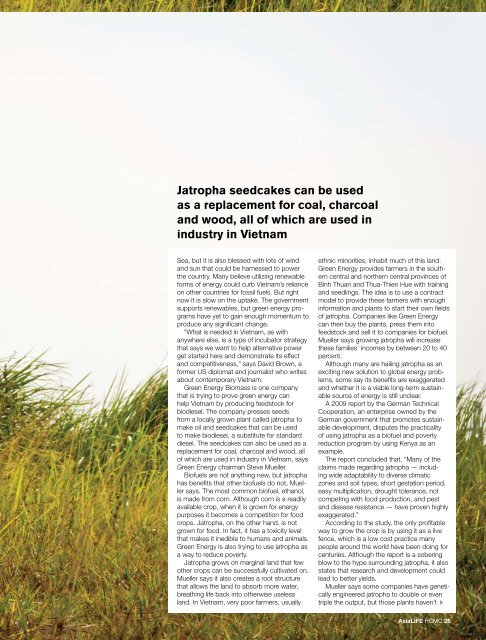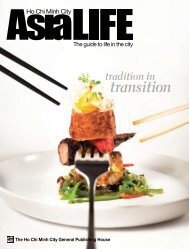Create successful ePaper yourself
Turn your PDF publications into a flip-book with our unique Google optimized e-Paper software.
Jatropha seedcakes can be usedas a replacement for coal, charcoaland wood, all of which are used inindustry in VietnamSea, but it is also blessed with lots of windand sun that could be harnessed to powerthe country. Many believe utilizing renewableforms of energy could curb Vietnam’s relianceon other countries for fossil fuels. But rightnow it is slow on the uptake. The governmentsupports renewables, but green energy programshave yet to gain enough momentum toproduce any significant change.“What is needed in Vietnam, as withanywhere else, is a type of incubator strategythat says we want to help alternative powerget started here and demonstrate its effectand competitiveness,” says David Brown, aformer US diplomat and journalist who writesabout contemporary Vietnam.Green Energy Biomass is one companythat is trying to prove green energy canhelp Vietnam by producing feedstock forbiodiesel. The company presses seedsfrom a locally grown plant called jatropha tomake oil and seedcakes that can be usedto make biodiesel, a substitute for standarddiesel. The seedcakes can also be used as areplacement for coal, charcoal and wood, allof which are used in industry in Vietnam, saysGreen Energy chairman Steve Mueller.Biofuels are not anything new, but jatrophahas benefits that other biofuels do not, Muellersays. The most common biofuel, ethanol,is made from corn. Although corn is a readilyavailable crop, when it is grown for energypurposes it becomes a competition for foodcrops. Jatropha, on the other hand, is notgrown for food. In fact, it has a toxicity levelthat makes it inedible to humans and animals.Green Energy is also trying to use jatropha asa way to reduce poverty.Jatropha grows on marginal land that fewother crops can be successfully cultivated on.Mueller says it also creates a root structurethat allows the land to absorb more water,breathing life back into otherwise uselessland. In Vietnam, very poor farmers, usuallyethnic minorities, inhabit much of this land.Green Energy provides farmers in the southerncentral and northern central provinces ofBinh Thuan and Thua-Thien Hue with trainingand seedlings. The idea is to use a contractmodel to provide these farmers with enoughinformation and plants to start their own fieldsof jatropha. Companies like Green Energycan then buy the plants, press them intofeedstock and sell it to companies for biofuel.Mueller says growing jatropha will increasethese families’ incomes by between 20 to 40percent.Although many are hailing jatropha as anexciting new solution to global energy problems,some say its benefits are exaggeratedand whether it is a viable long-term sustainablesource of energy is still unclear.A 2009 report by the German TechnicalCooperation, an enterprise owned by theGerman government that promotes sustainabledevelopment, disputes the practicalityof using jatropha as a biofuel and povertyreduction program by using Kenya as anexample.The report concluded that, “Many of theclaims made regarding jatropha — includingwide adaptability to diverse climaticzones and soil types, short gestation period,easy multiplication, drought tolerance, notcompeting with food production, and pestand disease resistance — have proven highlyexaggerated.”According to the study, the only profitableway to grow the crop is by using it as a livefence, which is a low cost practice manypeople around the world have been doing forcenturies. Although the report is a soberingblow to the hype surrounding jatropha, it alsostates that research and development couldlead to better yields.Mueller says some companies have geneticallyengineered jatropha to double or eventriple the output, but those plants haven’tasialife HCMC 25















